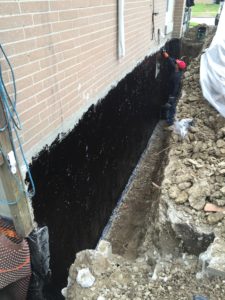07 Apr The Differences Between Wateproofing & Damp-proofing
 Waterproofing or damp-proofing? I know what you are probably thinking. “Are they not one in the same?” The answer surprisingly is no. The application of materials and sealants is actually somewhat different.
Waterproofing or damp-proofing? I know what you are probably thinking. “Are they not one in the same?” The answer surprisingly is no. The application of materials and sealants is actually somewhat different.
What is Damp-proofing?
The damp-proofing process keeps out soil moisture, while waterproofing keeps out moisture in addition to liquid water. Buildings have been damp-proofed for years and the practice was and is often mistakenly referred to as waterproofing.
Damp-proofing utilizes a coating technique. The coating (usually asphalt-based) is sprayed onto the wall or applied by hand. In more modern residential construction the process has since died down. It is however still an acceptable form of treatment in many situations.
Drawbacks
- An inability to seal larger cracks or holes left by concrete form ties (used to prevent concrete forms from spreading as a result of the fluid pressure of freshly placed, unhardened concrete)
- The possibility of damage caused by sloppy backfill.
- The process will only retard moisture; it cannot stop a large volume of water resting on the foundation
Despite said drawbacks, damp-proofing can provide adequate and long-term protection for many crawl spaces and basements if you have the following:
- Proper surface drainage
- Correctly installed foundation drains at the footing
- The absence of hydrostatic pressure to drive water penetration
What is Waterproofing?
Waterproofing, like damp-proofing, involves a surface treatment and drain pipe. The process, however, is much more thorough in the treatment of the wall itself. It is able to expand and bridge cracks in the foundation. Waterproofing can also withstand water under hydrostatic pressure and can also stop water vapour from entering a basement.
The waterproofing process involves:
- Excavating the foundation
- Repairing any damage to the foundation by parging
- Adding a footing level (where the foundation wall meets the footing)
- Applying a dimpled waterproofing membrane
- Installing new weeping tiles and backfilling the foundation
Exterior waterproofing and drainage are by far the best protection for a basement. When homes are being built the method is used almost exclusively. However, in retrofit (re-doing other systems that failed) situations, for older homes with the following, exterior waterproofing may be impractical.
- Established landscaping
- Connected utilities
- Air conditioners
- Patios
- Decks
- Additions
- Garages
Furthermore, if there is any doubt about whether or not damp-proofing will do the job, keep this in mind. It’s best to spend the extra time and money to waterproof, and particularly for habitable space.
Knowing the difference between these two processes will protect you from dealing with Toronto waterproofing companies that may accidentally or purposefully try and provide you with the wrong service.






No Comments